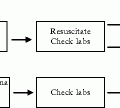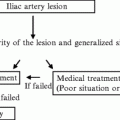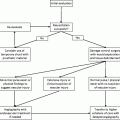Amit Kumar and Kenneth Ouriel (eds.)Handbook of Endovascular Interventions201310.1007/978-1-4614-5013-9_39© Springer Science+Business Media New York 2013
39. Simulators in Endovascular Treatment
(1)
The Methodist Hospital Research Institute, The Methodist Hospital, Houston, TX, USA
(2)
Division of Vascular Surgery, Department of Cardiovascular Surgery, The Methodist DeBakey Heart & Vascular Center, The Methodist Hospital, 6550 Fannin Street, Suite 1401, Houston, TX 77030, USA
Abstract
Training in Vascular and Endovascular Surgery faces enormous challenges as a consequence of rapidly evolving technology and changes in postgraduate medical education (e.g., restriction of working hours thereby effectively reducing operative time). Traditionally, Vascular Surgery training has distinguished itself by being a low-volume/high-complexity specialty, systematically focused on case load to determine its adequacy. As new training paradigms are being developed and assessed for vascular residents, simulator-based training will become crucial to the trainee’s proficiency.
The authors have no competing interests to declare and received no financial contributions.
1 Introduction
Training in Vascular and Endovascular Surgery faces enormous challenges as a consequence of rapidly evolving technology and changes in postgraduate medical education (e.g., restriction of working hours thereby effectively reducing operative time). Traditionally, Vascular Surgery training has distinguished itself by being a low-volume/high-complexity specialty, systematically focused on case load to determine its adequacy. As new training paradigms are being developed and assessed for vascular residents, simulator-based training will become crucial to the trainee’s proficiency.
2 What Is a Simulator?
Simulation is used in many contexts, including the modeling of natural systems or human systems in order to gain insight into their functioning. Virtual reality (VR) simulations have long been used as training and evaluation tools in aviation and other professions. Medical simulation is defined as a “person, device or set of conditions which attempts to present education and evaluation of problems authentically.” Simulation-based training in medicine and surgery has only recently become generally accessible. The broad consensus is that the new technologies will become an integral part of how vascular surgeons acquire new procedural skills and are assessed for proficiency and maintenance of competency.
Endovascular therapy is increasingly being applied to all territories of the vascular system, and a different set of skills is required when compared with open surgery. Simulations represent an excellent opportunity for training in procedures and management of potential complications; although it does not replace clinical training, it completely avoids the risks of patient injury and medicolegal liability associated with hands-on training in patient care settings. Rather, it offers a means for mentored instruction in a more realistic way than can be provided with demonstration, and it is more efficient (more cases can be practiced), more realistic (human anatomy and physiology are modeled), and less expensive than training in large-animal models.
3 Types of Simulators
Simulations are categorized into two broad groups:
1.
Low fidelity (LF)
2.
High fidelity (HF)
LF simulations use materials and equipment that are different from those used for the task being considered. HF simulations use realistic materials and equipment to reproduce or represent the setting task. HF endovascular procedure simulators provide real-time interactive simulation, two-dimensional graphic displays of angiographic anatomy and mechanical interfaces with guide wires, sheaths, and catheters, which provide some degree of haptic feedback.
3.1 The Available Simulation Models for Endovascular Skills Are as Follows
A.
Synthetic: These models range from low fidelity solid plastic models to high fidelity systems with fluoroscopy and pulsatile flow. This is relatively inexpensive and benefits from being portable, simple to set up, and radiologic screening is not often required; among its disadvantages is the fact that they cannot fully replicate the dynamic behavior of the human arterial circulation in terms of the elasticity of arterial walls or blood flow.
B.
Large animal models offer highly realistic training options for advanced interventions with the possibility of artificially inducing blood vessel lesions by endothelial injury and sutured patches. On the other hand, some of the disadvantages are the fact that the use of animal models is limited by expense, legal and ethical issues and the requirement for specialist facilities as well as the knowledge of the anatomical and size differences compared to human bodies.








